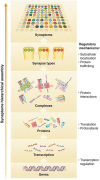Synapse diversity and synaptome architecture in human genetic disorders
- PMID: 31348488
- PMCID: PMC6872429
- DOI: 10.1093/hmg/ddz178
Synapse diversity and synaptome architecture in human genetic disorders
Abstract
Over 130 brain diseases are caused by mutations that disrupt genes encoding the proteome of excitatory synapses. These include neurological and psychiatric disorders with early and late onset such as autism, schizophrenia and depression and many other rarer conditions. The proteome of synapses is highly complex with over 1000 conserved proteins which are differentially expressed generating a vast, potentially unlimited, number of synapse types. The diversity of synapses and their location in the brain are described by the synaptome. A recent study has mapped the synaptome across the mouse brain, revealing that synapse diversity is distributed into an anatomical architecture observed at scales from individual dendrites to the whole systems level. The synaptome architecture is built from the hierarchical expression and assembly of proteins into complexes and supercomplexes which are distributed into different synapses. Mutations in synapse proteins change the synaptome architecture leading to behavioral phenotypes. Mutations in the mechanisms regulating the hierarchical assembly of the synaptome, including transcription and proteostasis, may also change synapse diversity and synaptome architecture. The logic of synaptome hierarchical assembly provides a mechanistic framework that explains how diverse genetic disorders can converge on synapses in different brain circuits to produce behavioral phenotypes.
© The Author(s) 2019. Published by Oxford University Press. All rights reserved. For Permissions, please email: journals.permissions@oup.com.
Figures



Similar articles
-
Architecture of the Mouse Brain Synaptome.Neuron. 2018 Aug 22;99(4):781-799.e10. doi: 10.1016/j.neuron.2018.07.007. Epub 2018 Aug 2. Neuron. 2018. PMID: 30078578 Free PMC article.
-
Hierarchical organization and genetically separable subfamilies of PSD95 postsynaptic supercomplexes.J Neurochem. 2017 Aug;142(4):504-511. doi: 10.1111/jnc.14056. Epub 2017 Jul 25. J Neurochem. 2017. PMID: 28452394 Free PMC article.
-
A brain atlas of synapse protein lifetime across the mouse lifespan.Neuron. 2022 Dec 21;110(24):4057-4073.e8. doi: 10.1016/j.neuron.2022.09.009. Epub 2022 Oct 5. Neuron. 2022. PMID: 36202095 Free PMC article.
-
Synaptopathies: diseases of the synaptome.Curr Opin Neurobiol. 2012 Jun;22(3):522-9. doi: 10.1016/j.conb.2012.02.002. Epub 2012 Mar 10. Curr Opin Neurobiol. 2012. PMID: 22409856 Review.
-
The postsynaptic organization of synapses.Cold Spring Harb Perspect Biol. 2011 Dec 1;3(12):a005678. doi: 10.1101/cshperspect.a005678. Cold Spring Harb Perspect Biol. 2011. PMID: 22046028 Free PMC article. Review.
Cited by
-
Novel missense mutations in PTCHD1 alter its plasma membrane subcellular localization and cause intellectual disability and autism spectrum disorder.Hum Mutat. 2021 Jul;42(7):848-861. doi: 10.1002/humu.24208. Epub 2021 May 3. Hum Mutat. 2021. PMID: 33856728 Free PMC article.
-
Proteomic insights into synaptic signaling in the brain: the past, present and future.Mol Brain. 2021 Feb 17;14(1):37. doi: 10.1186/s13041-021-00750-5. Mol Brain. 2021. PMID: 33596935 Free PMC article. Review.
-
Electrical synapse structure requires distinct isoforms of a postsynaptic scaffold.PLoS Genet. 2023 Nov 27;19(11):e1011045. doi: 10.1371/journal.pgen.1011045. eCollection 2023 Nov. PLoS Genet. 2023. PMID: 38011265 Free PMC article.
-
Data-driven synapse classification reveals a logic of glutamate receptor diversity.bioRxiv [Preprint]. 2025 Jan 14:2024.12.11.628056. doi: 10.1101/2024.12.11.628056. bioRxiv. 2025. PMID: 39713368 Free PMC article. Preprint.
-
A single-synapse resolution survey of PSD95-positive synapses in twenty human brain regions.Eur J Neurosci. 2021 Oct;54(8):6864-6881. doi: 10.1111/ejn.14846. Epub 2020 Jun 25. Eur J Neurosci. 2021. PMID: 32492218 Free PMC article.
References
-
- Husi H., Ward M.A., Choudhary J.S., Blackstock W.P. and Grant S.G. (2000) Proteomic analysis of NMDA receptor-adhesion protein signaling complexes. Nat Neurosci., 3, 661–669. - PubMed
-
- Husi H. and Grant S.G. (2001) Isolation of 2000-kDa complexes of N-methyl-D-aspartate receptor and postsynaptic density 95 from mouse brain. J. Neurochem., 77, 281–291. - PubMed

